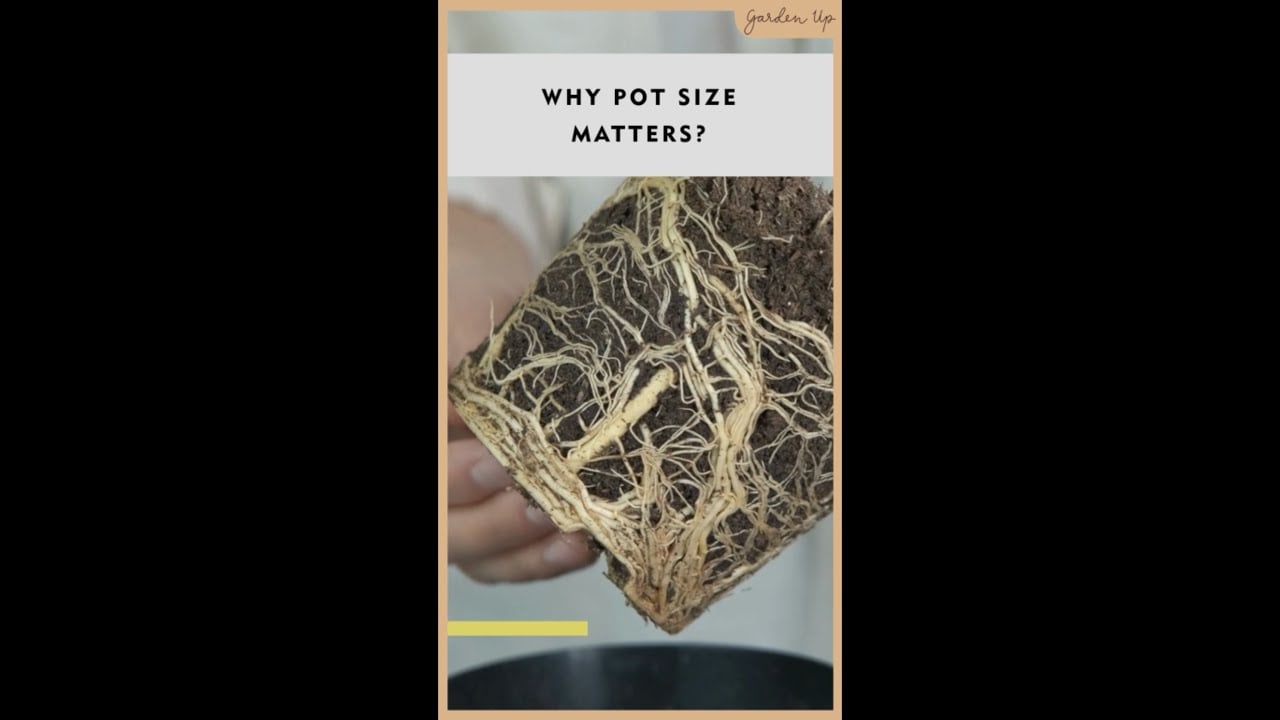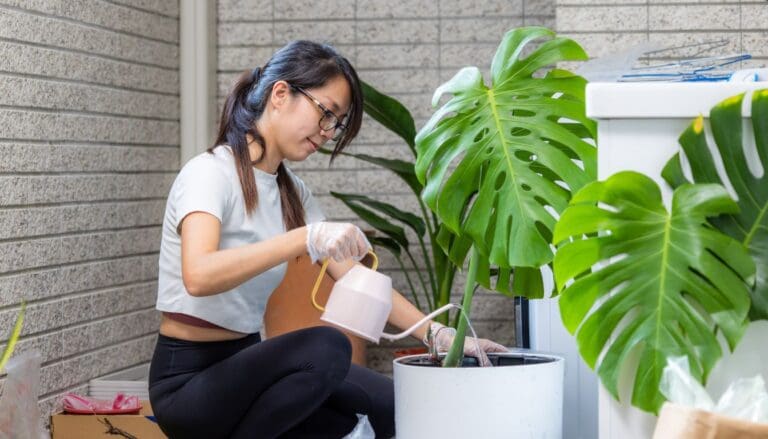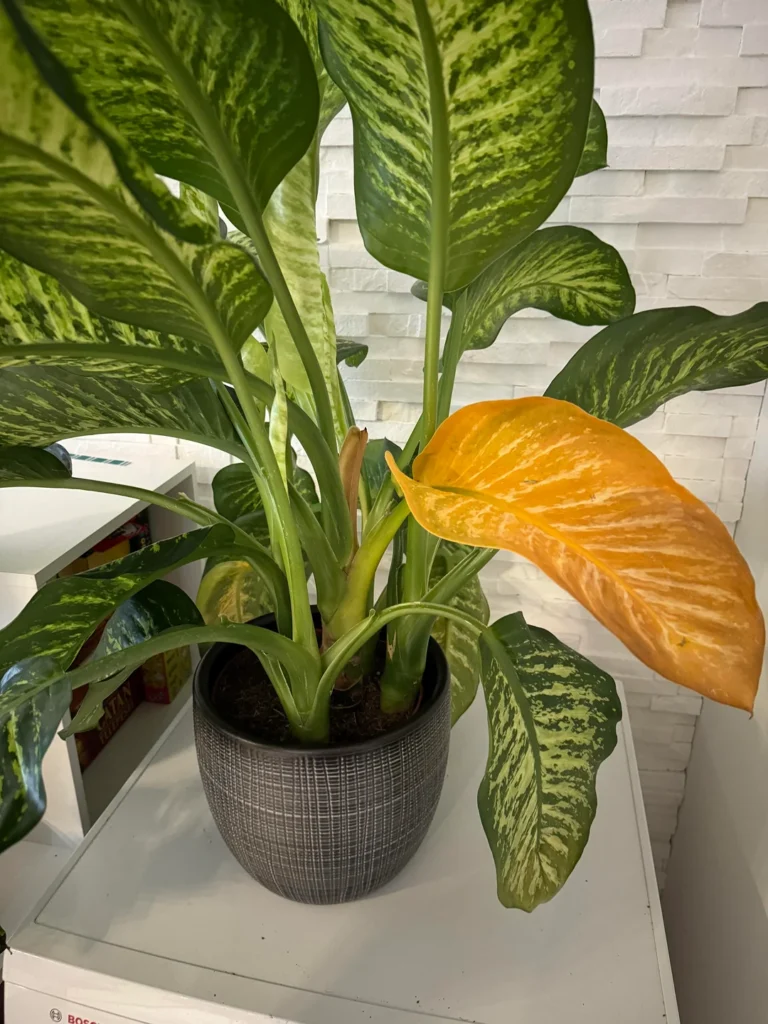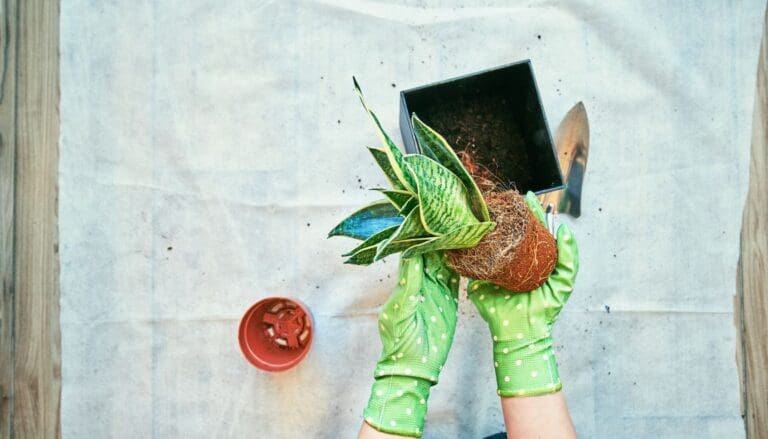Overpotting Disaster: How Choosing a Too-Big Pot Can Spoil Your Plant!
While it seems like a good idea to use a pot bigger than your plant needs, the mismatch between the pot and plant sizes can do more harm to the plant than any good. Let’s see what happens if a plant is overpotted.
When you put a plant in a pot that is too big, it holds too much soil. The plant keeps growing roots to fill the space in the soil. Besides, the soil can retain moisture for too long when watered, causing overwatering and root rot. You need a right-sized pot that suits your plant.
Are you struggling with something similar? Go through this guide to learn how to select the ideal new pot size and the consequences of choosing a pot much bigger than the plant needs.

Please note: Simplify Plants is reader-supported. Some links in the post are affiliate links and I get a commission from purchases made through links in the post.
Understanding pot size and plant health
Before getting to the main point, let’s learn some basics about pot size and plant health.
Selecting the right size for any plant has always been the most complicated thing for me.
I never understood what size of pot would be ideal for my houseplants.
As a beginner, I struggled to choose the right pot size.
After years of experience, I struggle less, but it isn’t over.
Different sizes of pots are available, from small to large pots, tall pots, wide and short pots, and narrow and deep pots.
You need to get one that suits your plant size.
Large potted plants vs. Small potted plants
Both small and large pots can be detrimental to your plant.
In a small pot, soil dries quickly, and you must water frequently.
Additionally, it restricts root growth and causes stunted growth.
In contrast, an overly large pot holds too much soil, which takes forever to dry out, making the plant susceptible to root rot and pests.
Some people think that it encourages quick growth.
But that’s not the case.
It all depends on how much you care for the plant and whether it receives all the resources: light, moisture, nutrients, temperature, and humidity.
You need a pot that holds enough soil for the plant to stand straight and absorb sufficient water and nutrients.
Biologists have studied that moving a plant to the correct pot size can increase the plant’s health by 50%.
Pot size rule of thumb
I have struggled for years to understand the correct pot size for a plant.
After researching and watching videos, I learned a rule about choosing the right pot size.
You must choose a pot 1-2 inches bigger than your old one.
For example, if you have a 4-inch pot, use a 6-inch pot while repotting.
Based on your plant’s growth speed, choose a pot that is only one or two sizes bigger than the old one.
This way, you can shift your plant to a pot that is neither too big nor too small but just perfect for the plant.
What happens if you put a plant in a pot too big?

Using a pot much larger than what your plant needs can harm its health.
Below are 6 common and adverse effects on your plant’s health from using a pot too big:
1. A big pot causing overwatering and root rot
One of the common issues you will face while using a bigger pot is overwatering and root rot.
A big pot can hold a lot of soil.
When watered, the soil takes a lot of time to dry out.
The roots, too, stay wet for too long.
Over that, following a watering schedule without checking the soil’s moisture level will cause overwatering.
Your plant leaves will try to inform you about the watering stress through some signs like yellowing or wilting.
If you continue ignoring them and water the plants, you will face another issue called Root rot, where the roots start decaying.
If the roots are unhealthy and dying, saving the plant will be difficult.
Also read: How Long Can Your House Plants Really Thrive Without Water?
2. Big pot causes excessive root growth
While choosing a bigger pot for a plant might seem fine, it does more bad than good.
When you use a pot with excessive space, you will need to fill the pot correctly with soil and then plant the roots.
Upon providing too many resources, the plant will put extra effort into filling the oversized pot and developing a strong root system.
Over time, you will notice little leaf or plant growth for a long time.
It may seem like your plant has stunted its growth.
3. A big pot leads to stunted growth
One problem that leads to stunted growth is overwatering and excessive root growth.
A big pot needs too much soil, but your plant may not need that much soil.
So, if the soil is too much, the plant takes much time to absorb the nutrients.
Lack of nutrition can lead to stunted growth in your potted plant.
When the plant struggles to absorb the nutrients, the salt from the fertilizers will accumulate on the soil surface.
It can also hinder the plant’s absorption of nutrients, leading to stunted growth.
4. Using a big pot can waste resources
When the plant is smaller than the pot and the amount of soil you are using, the plant struggles to absorb the nutrients and moisture entirely from the soil.
For this, half of the provided resources get wasted.
5. Pest and disease problems

Excessive moisture can attract pests and pathogens, further harming your plant.
Root rot also attracts pests and insects that love feeding on and damaging the plant.
The problem is exacerbated when high humidity levels accompany prolonged dampness.
6. A big pot decays the potting mix
When the potting mix remains wet constantly, it not only affects the plant’s health but also makes the soil unhealthy.
Prolonged wet conditions can degrade the potting mix quality.
Plants growing in such soil become prone to infestations faster.
Slowly, you will see that the soil’s level is reducing and going downwards.
When the potting mix stays wet too long, fungus gnats will visit your plant.
These tiny flies will be seen roaming around the overwatered plant.
Their larvae will begin feeding on the fungus that breaks down the wet potting mix.
Symptoms indicating that you are using a big pot for your plant
When you put a plant in a big pot, it will show a few symptoms to tell you that they are enjoying their surrounding growing conditions:
- The leaves are wilting or drooping.
- Leaves are turning yellow or brown.
- Leaves are falling off.
- You notice stunted growth for too long.
- The potting mix is very wet and soggy for a long time.
- The potting soil is sinking, and its level is dropping in the pot because it is breaking down and decomposing due to prolonged wet conditions.
- Too many fungus gnats flying around the potting mix.
Remedies and prevention for a plant growing in a pot too big
As a beginner, you will use the wrong pot size, thinking you are giving enough space and don’t have to repot them frequently.
Once the plant starts suffering, they learn that their decision was wrong.
Did you make the same wrong decision?
Don’t worry; I will provide some easy remedies to get your plant out of the problem and prevent the same from happening.
Rescuing plants from overpotting
If you have already put your plant in a huge pot, there are a few things you need to manage:
- The wet potting mix
- Excessive root growth, which reduces the leaf and plant growth
- Overwatering and root decay
To address these issues:
- Watering in the large pots can be tricky. Stop watering the plant by following any strict schedule. It will keep your plant and the potting mix from getting waterlogged. Instead, check the soil moisture regularly with your finger. You can water the plant whenever the top few inches are dry.
- If your pot is placed over a saucer, empty it regularly.
- You can add more plants to the pot if it is too big. Consider adding short-lived annuals, fast-growing short-harvest plants, short plants in nature, or slow-growers together.
- You need to repot your plant to a smaller pot. Choose a plant that is 1-2 inches larger than your plant’s root ball. If the roots start to rot, remove the damaged roots. After repotting, water the plant with seaweed extract. This one contains natural root growth stimulants and helps the roots grow and recover faster.
- Prune off some excess leaves and branches. Do not remove more than ⅓rd of the total leaves.
- Allow the plant some time to recover. If the treatment is correct, you will soon see signs of recovery, like new leaves.
Now, let’s learn some preventive measures.
Also read: Cracking the Code: Overwatering vs. Underwatering—Solutions You Need to Know!
Preventing overpotting

To prevent your plant from suffering because of an oversized pot, you should avoid potting the plant in an oversized pot.
Below are some preventive measures you can take to prevent your precious plant from struggling.
Pot size rule
One strict preventive measure to prevent the plant from suffering from the above issues is choosing the right pot size for your plant.
Choose the pot size that comes after your present pot size.
Based on the plant’s growth speed, you can go for a pot around 1-2 inches bigger than the old one.
For example, if your plant is potted in a 4-inch pot, you must choose a 6-inch or an 8-inch pot for the plant to repot.
For large or fast-growing plants, choose a pot 2-4 inches larger than the current one.
Time of repotting
Every plant receives a transplant shock when repotted because of the sudden environmental change.
Make sure to repot your plant during its growing season so that the plant can recover and have new growth faster.
Pot type
You can use self-watering pots for your plant.
These pots will water your plant as per your plant’s need without overwatering or underwatering it.
You only need to check the reservoir and fill it occasionally.
Adjusting tall pots
Oversized pots are also a problem due to their depth, especially for plants with shallow root systems.
There is a solution for this.
You do not need to fill up the entire pot with soil. Use the space required for your plant. For that:
- Fill the bottom half of the pot with a lightweight but sturdy material, such as scorcia, a red-brown volcanic rock filled with air spaces.
- Cover it with a layer of shading cloth or geotextile fabric to prevent the potting mix from falling below.
- Now, fill the pot with the ideal potting mix needed for the plant.
- Do not use any polystyrene foam layer at the pot’s bottom. It can break down, and your soil level will go down again.
- You can also add a layer of organic compost to promote plant growth.
Another solution is to place the plant in the regular pot size and then make the pot sit over an inverted plastic or terracotta pot inside the tall pot to make up for the height.
Tips for determining the correct pot size for your plant
I have put a lot of effort into choosing the ideal pot size.
But now, I am well-acquainted with it.
Do you need help with what size of pot you should choose for your plant?
Here, I will share some tips to help you select the right pot size.
The general rule is to select a pot that is only 1-2 inches larger than the existing one.
But a few more things can affect the size.
Let’s learn the tips:
Consider the plant size and growth features
You have repotted and used an oversized pot for your plant.
Now your plant is suffering, but you forgot the size of the old pot.
In such cases, you can choose the right pot size from the plant size.
Measure the plant size, go to the nursery store, tell the staff your plant’s size, and ask them for an ideal pot size.
The members can help you get the right pot size for your plant.
There are several types of plants with different features and characteristics.
You must understand their health conditions and behavior to choose the right pot size.
Compact plants like African Violets prefer being root-bound for some time, as it encourages flowering.
For these, you can choose a small pot.
Plants like Peace Lilies, Rubber, and Monstera need a bigger pot.
Some plants are slow growers, and some are very fast growers.
While choosing the pot size for slow growers, you can choose a pot that is 1-2 inches bigger than the old one.
For the fast-growers that grow large very quickly, select a 2-4 inch larger pot.
Since they are fast growers, they need space to grow and develop well.
Drainage considerations in the pots
Before considering the decor, check for the pot’s drainage system.
Every pot should have sufficient drainage holes at the bottom for the excess water to drain out.
If you have bought a pot for decor that doesn’t have drainage holes, make one using a drill machine at the bottom.
No one’s going to see it anyway.
If you don’t want that, use it as a cache pot.
Put in a plastic or terracotta pot with drainage holes inside your designed pot.
It is called double potting.
When water drains, it falls at the bottom of the cache pot.
It will work as a saucer.
Just like you need to empty the saucer, you must also empty the pretty pot.
Since this is quite the job, I would not recommend it.
Your plant can get hurt while trying to take it out of the cache pot for emptying.
Understanding the potting material
The potting material is also essential.
The common materials used by most houseplant owners are terracotta, plastic, and ceramics.
Plastic pots are colorful, cheap, and lightweight.
Since these can retain moisture for a long, you don’t need to water the plant frequently.
Terracotta pots are breathable and prevent overwatering.
They are ideal for plants needing good drainage and dry conditions.
Ceramic pots add aesthetic value to your indoor corners.
They come in various shapes, designs, and colors.
Repotting frequency

Some plants are fast growers, and some are slow growers.
The fast growers need frequent repotting, and the slow growers need significantly less repotting.
When selecting the pot size, keep the growth habit of your plant in mind.
If your plant is a fast grower, you must choose a pot 2-4 inches bigger than the existing one.
As for the slow grower, go for a 1-2 inch bigger pot.
Pot size guide:
- 4-inch pot: Ideal for seedlings and small nursery plants
- 5 to 6-inch pot: Small succulents and annual flowers
- 7 to 8-inch pot: Large succulents
- 10-inch pot: Small herbs
- 16-inch pot: Rosemary and large herbs
- Spider plant: 4-6 inch pot initially. Later, it will need an 8-10 inch pot.
- Rubber plant: Make sure the pot is always 1-2 wider than the older one in diameter
- African violets: Select a 2.5-inch pot for the smaller varieties and a 4 to 5-inch pot for the larger varieties.
- Peacock plant or Calathea Makonaya: It thrives best in a pot with a 6-8 inch diameter.
- Large Monstera: Choose a pot that is always 2 inches larger in diameter than the old one. A 10-12 inch pot is ideal for a medium Monsteras, but the larger ones need 14-16 inch pots.
- Fiddle Fig leaves: They need a pot 2 inches larger in diameter. A 12-14 inch pot should suffice.
- These are some average pot sizes. It can vary based on your current plant size.
Final thoughts
Soil is an essential source of material for all plants. Choosing the correct pot size is crucial for a potted plant to hold sufficient soil for the plant’s good health.
A small pot can hinder the plant’s growth. But that doesn’t mean you should choose a big pot. It does more bad than good. Since a big pot holds too much soil, drying takes forever.
When the roots stay wet for that long, it leads to overwatering and root rot. Other issues are stunted growth, soil decaying, and pests.
Also, the plant initially concentrates more on strong root growth upon providing adequate moisture and nutrients. This reduces the growth of leaves and flowers.
To rescue your plant from overpotting, check the moisture level, add more plants, and prune some leaves to help the plant focus on leaf growth.
At last, repot your plant to the correct pot size. Choose a pot 1-2 inches bigger than the old one. Consider the plant’s growth habit, repotting frequency, drainage, and the material.
Will my plant grow faster if I use a bigger pot?
Your plant is not going to grow quickly because of the big pot. It depends on your plant’s health, how much you care for it, and how well they respond to the provided resources. A big pot only hinders your plant growth.
Will my plant die if I use a pot too big?
Initially, it won’t kill your plant. But over time, you will have issues like overwatering, stunted growth, yellowing, and wilting. If this continues, then your plant may die.
Reference: Pot Size Wikipedia
Recommended Garden Supplies
| Product Image | Our Recommended Gardening Supplies | Check Offers! |
|---|---|---|
Top Top
Top
Top
Top
Top
Top
Top
Top | rePotme Houseplant and Tropical Classic Potting Soil Mix | Check Offer On Amazon |
 Top
Top
Top
Top
Top
Top
Top
Top | Espoma Organic Indoor Plant Food | Check Offer On Amazon |
 Top
Top
Top
Top
Top
Top
Top
Top | GooingTop LED Grow Light 6000K Full Spectrum Clip Plant Growing Lamp | Check Offer On Amazon |
 Top
Top
Top
Top
Top
Top
Top
Top | Soil Moisture Meter | Check Offer On Amazon |
 Top
Top
Top
Top
Top
Top
Top
Top | Govee Hygrometer Thermometer, Bluetooth Enabled! | Check Offer On Amazon |
 Top
Top | LEVOIT Humidifiers for Large Room(Best For Plants) | Check Offer On Amazon |
 Top
Top
Top
Top
Top
Top
Top
Top | Upgraded DIY Automatic Drip Irrigation Kit, 15 Potted Houseplants Support | Check Offer On Amazon |
 Top
Top
Top
Top
Top
Top
Top
Top | Stainless Steel Heavy Duty Gardening Tool Set | Check Offer On Amazon |
 Top
Top
Top
Top
Top
Top
Top
Top | Bonide Insecticidal Soap | Check Offer On Amazon |
 Top
Top
Top
Top
Top
Top
Top
Top | Bonide 32 oz Spray Neem Oil for Organic Gardening | Check Offer On Amazon |
 Top
Top
Top
Top
Top
Top
Top
Top | Garden Safe Fungicide | Check Offer On Amazon |








Hi, is there a solution to a root rot plant? I made the mistake of planting my devil’s backbone in an inappropriate large planter; hence my plant is sick. Do you have any recommendations to bring it back to it’s original state? Thank you…
Root rot can be a serious issue for plants and can be caused by overwatering, poor drainage, or soil that is too heavy and does not allow air to circulate around the roots. If your devil’s backbone plant is suffering from root rot, there are a few steps you can take to help it recover:
Remove the plant from the pot: Carefully remove the plant from the pot and inspect the roots. If the roots are brown, mushy, and have a foul smell, they are likely affected by root rot.
Trim off damaged roots: Use a clean, sharp pair of scissors or pruning shears to trim off any damaged roots. Cut back to healthy tissue and remove as much of the affected root system as possible.
Repot the plant: Repot the plant in a clean pot with fresh soil that is well-draining and rich in organic matter. Make sure the pot has drainage holes to allow excess water to drain away.
Water the plant properly: Water the plant deeply but infrequently, and allow the soil to dry out slightly between waterings. Avoid overwatering, which can cause water to accumulate in the soil and suffocate the roots.
Provide proper light: Devil’s backbone plants prefer bright, indirect light, so make sure the plant is getting enough light but is not exposed to direct sunlight.
Consider using a fungicide: If the plant has developed root rot, you may need to use a fungicide to treat the soil and prevent further infection. Be sure to follow the instructions carefully and use a product that is safe for your plant.
It is important to note that plants affected by root rot can be difficult to save, and success will depend on the severity of the damage and how quickly you are able to address the issue. With proper care and attention, your devil’s backbone plant may be able to recover and thrive.